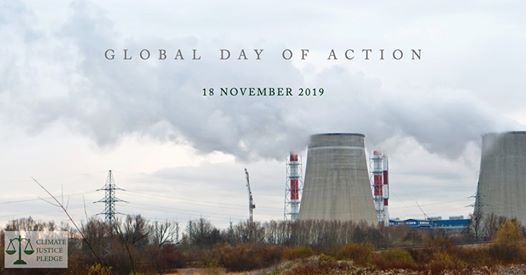via UofT Faculty of Law News: https://www.law.utoronto.ca//news/students-call-ontario-and-federal-governments-act-air-pollution

Today, November 18th, is the Student Law Clinic Global Day of Action for Climate Justice. We are a student working group at the University of Toronto Faculty of Law and, on this day, we call on our provincial and federal governments to take meaningful action to curb emissions in Ontario. The harmful consequences of air pollution are widespread and government inaction only exacerbates them. In Sarnia’s “Chemical Valley”, for example, where petrochemical facilities are responsible for around 10% of Ontario’s total emissions, the government’s inadequate regulations and foot-dragging have contributed to a health and environmental crisis.
The health data speaks for itself. Sarnia’s cancer rates are significantly higher than the rest of Canada’s. In the Aamjiwnaang First Nation community, whose traditional lands are just south of the city, the birth ratio of baby girls to boys is nearly 2:1. A wide range of respiratory problems and conditions that impair lung function have been linked to the pollutants emitted by Chemical Valley’s oil refineries and chemical plants. The list goes on. These findings are deeply troubling and should have spurred government action long ago. While we are encouraged that the provincial government will begin a two-year health study in Sarnia this fall, this is, in itself, insufficient.
Last month, a whistleblower painted a damning picture of the government’s response to air pollution in Chemical Valley. The whistleblower lodged three complaints between 2009 and 2019 alleging inadequate engagement with the Aamjiwnaang community. The Ontario government’s reluctance to take effective action on this issue is, unfortunately, not without precedent. In 2018, Ecojustice brought an application for review of the province’s air quality standards pursuant to Ontario’s Environmental Bill of Rights on behalf of two affected individuals. The government did not change its course.
Fortunately, there is another way to hold our governments accountable. The idea of using the Constitution to defend environmental rights is gaining momentum. Both the provincial and federal governments have clear duties under the Canadian Charter of Rights and Freedoms to protect the Aamjiwnaang community and other residents of Chemical Valley from the pollution that affects their land and their persons.
Section 7 of the Charter recognizes every individual’s right to life, liberty and security of the per-son. It encompasses the right to be free from physical or psychological harm resulting from gov-ernment actions or omissions, and could arguably be invoked to protect individuals from future harm. The negative health outcomes in Chemical Valley, if they are conclusively linked to deficient regulations, could form the basis of a section 7 claim.
Section 15 of the Charter protects individuals from discrimination. A law or policy that inordinately affects individuals on the basis of race, ethnic origin, or other grounds may constitute discrimination under the Constitution. Following a recent visit to Canada, the United Nations Special Rapporteur on human rights and hazardous substances and wastes, Mr. Baskut Tuncak, not-ed not only the inadequacy of the existing regulatory framework, but also its “deeply unsettling” impact on the Aamjiwnaang First Nation. A 2017 report of the Environmental Commissioner of Ontario similarly observed that “Indigenous people and communities are disproportionately affected by environmental problems.” The recently reelected Liberal government ought to be especially concerned about these findings, given its campaign promise to fully implement the UN Declaration on the Rights of Indigenous Peoples, which recognizes Indigenous peoples’ “right to the conservation and protection of the environment.”
Governments have a legal duty to correct the harmful and discriminatory regulatory schemes and environmental policies that are endangering communities across Canada. From Chemical Valley to Alberta’s tar sands, the dire consequences of government inaction are becoming increasingly clear. Last month’s federal election revealed voters’ renewed focus on climate-related issues. Climate strikes galvanized students across the country and drew attention to the social inequalities that flow from bad environmental policy. A group of young Canadians recently initiated a lawsuit against the federal government for infringing their Charter rights by not taking sufficient steps to combat climate change. These developments show that Canadians want better air quality, sustainability, and environmental rights. Provincial and federal governments should take note and take action before it’s too late.
Climate Justice working group members:
1Ls (first-year law students):
Clara Pencer
Adam LaRiviere
Mackenzie Cumberland
Madeleine Andrew-Gee
Leah Kelley
Leora Chapman
Courtney Cowan
Florian Nagy
Madeleine Carswell
Haleigh Ryan
Group leaders:
Yara Willox (2L)
Keely Kinley (2L)
